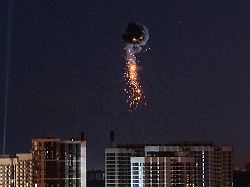Technological arms race
Ukraine seeks new means against kamikaze drones
7/5/2023 2:51 p.m
Again and again Russia terrorizes Ukrainian cities with cheap kamikaze drones from Iran. They’re hard to stop. But technicians now want to find new means against this weapon – an insight into the technological arms race in the war.
They are cheap. You are effective. They spread terror – kamikaze drones. The Russian military has long used Iranian “Shahed” drones in the war against Ukraine. They are difficult to stop, flying in swarms to their targets and exploding on impact. Ukraine is seeking remedies against this weapon that can wreak havoc. At the end of June, hundreds of engineers and inventors met with military leaders in Kiev. Hidden from the public, they discussed how the drones could be better neutralized. Reuters news agency was the only media company admitted to the event.
It offered a rare glimpse into Ukraine’s arms race with Russia. “Today’s war is technological, and every day there are changes in technology and in the battlefield,” said Mykhailo Fedorov, Minister for Digital Transformations and Deputy Prime Minister on the sidelines of the gathering. Organizers handed out $3 million in prize money to three teams of experts believed to have presented the best drones or electronic warfare technologies against the “Shahed”. These drones are a major problem for Ukraine’s air defense and energy supply protection.
Costs for drone destruction should be reduced
In May, according to official data, Russia attacked with more than 300 drones, more than ever before. In winter, Russia tried to paralyze Ukraine’s power grid with airstrikes. “We want to prepare for next winter to respond to these challenges,” said Deputy Prime Minister Oleksandr Kubrakov. This is difficult. Because the drones fly so low that they are often not detected by the air defense. At the same time, their navigation systems are so robust that their radio frequencies are difficult to jam. And they’re cheap. Western countries have deployed sophisticated defense systems to counter missile attacks.
Shooting down swarms of $50,000 drones with $1 million missiles is not ideal, government sources say. “It’s not profitable,” said Fedorov. “We must constantly bring down the cost of the funds we use to destroy ‘Shaheds’.” Olexandr, one of the participants whose names cannot be released for security reasons, said his team was presenting a quadrocopter. In addition to a propeller drive, this drone also has wings. It can fly much longer and faster than other drones. “It will be a drone that … takes off vertically to intercept or catch up, shoot down or block drones.”
Engineer Yuriy, another participant, reported that his team had come up with designs for new electronic warfare systems that were more effective against “shaheds” than the previous ones. Drones are also widely used in the wars in Yemen and Syria. But they have never been used more often than in Ukraine. “This is really an unprecedented drone war,” Fedorov said. Military innovation in Ukraine has boomed since the Russian invasion, he added. Last year, Ukraine launched a crowdfunding project aimed at creating an “army of drones.” The initiative has evolved into a government program that includes everything from the production of unmanned aerial vehicles to the training of drone pilots. “A few months after the start of the full-scale invasion, it became clear to everyone that UAVs were the most effective way of reconnaissance and defeating the enemy,” said Brigadier General Yuriy Shchyhol, who oversees procurement for the state program.
Production at several locations and in bunkers
So far, 15,000 drones have been purchased. Others would be procured by the Department of Defense, while others would be provided by volunteers and foreign supporters. It is not known how many drones Ukraine is using in the fight against Russian troops. Either way, she wants more. “Our goal this year is to buy more than 200,000 attack and large reconnaissance drones,” said Brigadier General Shchyhol. “We will buy as many drones as are available on the market.” Minister Fedorov said drone production is taking place across Ukraine, despite the threat of Russian airstrikes. Manufacturers were instructed to spread the work across multiple locations and use air raid shelters. “We can see that this approach works today.” More than 80 percent of the drones are manufactured and assembled domestically.
Anatoly Khrapchynskyi, who works for a company that develops electronic warfare technology, compared technological innovation in Ukraine to that in Russia: while Russia has a top-down approach and state organizations dominate, development in Ukraine is being driven by the private sector and involve many smaller companies. “When we started this project last year, there were seven companies that could sell drones to the state,” Fedorov explained. “Today it’s 40 and by the end of the year it will be 50.” State venture capital contributes to the expansion of domestic production. Ukraine also has the advantage of being able to share technology with foreign partners and not having to worry about sanctions. “Thanks to the funds, companies are starting to localize their production. Today we buy parts all over the world, including in China.”
